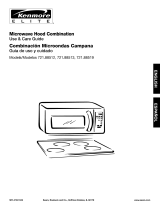
Before Operation
-4-
Installation and Earthing Instructions
(continuance)
General Use
1. In order to maintain high quality, do not operate
the oven when empty. The microwave energy will
reflect continuously throughout the oven if no food
or water is present to absorb energy.
2. Do not dry clothes, newspapers or other materials
in the oven. They may catch on fire.
3. Do not use recycled paper products, unless the
paper product is labelled as safe for microwave
oven use. Recycled paper products may contain
impurities which may cause sparks and/or fires
when used.
4. Do not use newspapers or paper bags for
cooking.
5. Do not hit or strike control panel. Damage to
controls may occur.
6. POT HOLDERS may be needed as heat from
food is transferred to the cooking container and
from the container to Ceramic Tray. The tray can
be very hot after removing the cooking container
from the oven.
7. Do not store flammable materials next to, on top
of, or in the oven. It could be a fire hazard.
8. Do not cook food directly on Ceramic Tray unless
indicated in recipes. (Food should be placed in a
suitable cooking utensil.)
9. Do NOT use this oven to heat chemicals or other
non-food products. Do NOT clean this oven with
any product that is labeled as containing corrosive
chemicals. The heating of corrosive chemicals
in this oven may cause microwave radiation
leaks.
10.
When using the COMBINATION mode, never
place any aluminum or metal container directly
on the wire rack. Always insert a heatproof, glass
plate or dish between the wire rack and the
aluminum container. This will prevent sparking
that may damage the oven.
11.
It is recommended not to use the wire rack when
cooking in the MICROWAVE mode only.
General Instructions
Earthing Instructions
This microwave oven must be earthed. In the event
of an electrical short circuit, earthing reduces the
risk of electric shock by providing an escape wire for
the electric current. This microwave oven is equipped
with a cord having an earthing wire with an earthing
plug. The plug must be plugged into an outlet that is
properly installed and earthed.
WARNING - Improper use of the earthing plug can
result in a risk of electric shock.
Circuit
Your microwave oven should be operated on a
separate 10 A circuit from other appliances. Failure
to do this may cause the power board fuse to blow,
and/or food to cook slower. Do not insert higher
value fuse in the power board.
Fan Motor Operation
After using the oven, the fan rotates to cool the
electric components. Do not switch the electricity off
for 5 minutes after using the oven. This continuance
of fan operation is perfectly normal, and you can
take out the food from the oven while the fan
operates.
12.
If ceramic tray is hot, allow to cool before cleaning
or placing in water.
Food
1. Do not use your oven for home canning or the
heating of any closed jar. Pressure will build
up and the jar may explode. In addition, the
microwave oven cannot maintain the food at the
correct canning temperature. Improperly canned
food may spoil and be dangerous to consume.
2. Do not attempt to deep fat fry in your microwave oven.
3. Potatoes, apples, egg yolks, whole squash,
chicken wing and sausages are examples of
foods with non porous skins. This type of food
must be pierced before cooking, to prevent
bursting.
4. When heating liquids, e.g. soup, sauces and
beverages in your microwave oven, overheating
the liquid beyond boiling point can occur without
evidence of bubbling. This could result in a
sudden boil over of the hot liquid. To prevent this
possibility the following steps should be taken:
a) Avoid using straight-sided containers with
narrow necks.
b) Do not overheat.
c) Stir the liquid before placing the container in the
oven and again halfway through cooking time.
d) After heating, allow to stand in the oven for
a short time, stirring again before carefully
removing the container.
5. DO NOT USE A CONVENTIONAL MEAT
THERMOMETER IN THE MICROWAVE OVEN.
To check the degree of cooking of roasts and
poultry use a MICROWAVE THERMOMETER.
Alternatively, a conventional meat thermometer
may be used after the food is removed from the
oven. If undercooked, return meat or poultry to
the oven and cook for a few more minutes at the
recommended power level. It is important to ensure
that meat and poultry are thoroughly cooked.




















